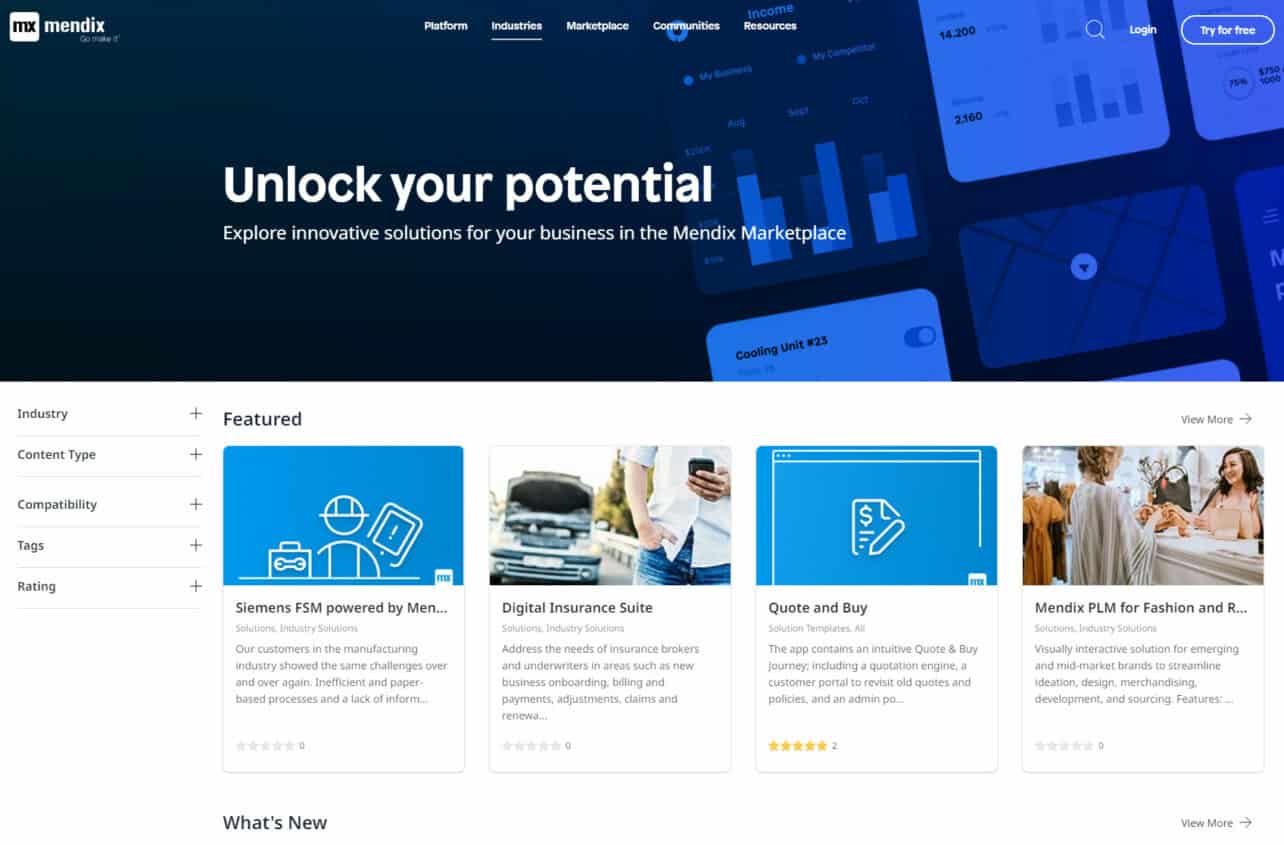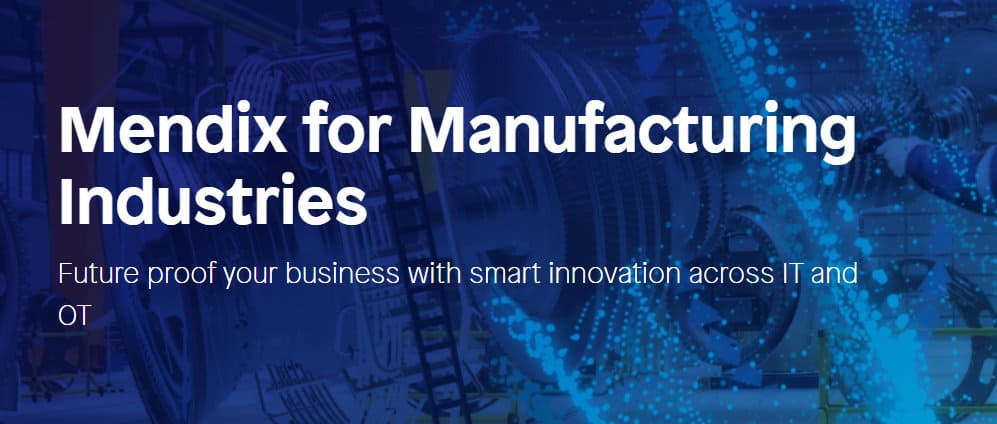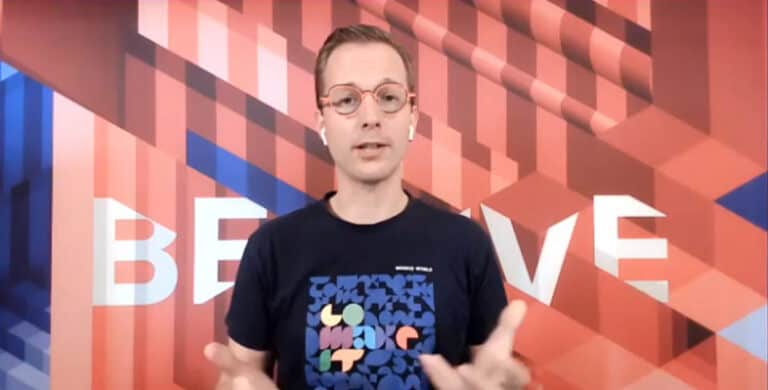Mendix has presented a lot of updates for its platform. The Mendix platform is made much more attractive for ISVs. There will be a more industry-specific focus and Mendix will even give the end-user access to no-code. With this, everyone can participate in building or adjusting apps to let their company innovate faster.
During Mendix World, Mendix presented the necessary updates for the Mendix platform. Prior to the event, we spoke with CTO Johan den Haan about the upcoming updates. Just like other years, Mendix presents many new features. If we bundle these features and look at it from a distance, we see two important strategic decisions.
The first decision is the one concerning independent software vendors (ISVs). Those who develop software, extensions or machine learning models for use on the Mendix platform are becoming increasingly important for the low-code specialist to enable the growth of the company and the platform. Mendix will keep the reins in its hands, but the company will mainly focus on the core of the platform. This while also leaving room for specialisations. The other big strategic decision we see is that Mendix will make building and improving applications more broadly available to a larger audience. It will now also provide end-users with tooling to build and adjust apps, without IT losing control of the whole thing.
Growth through ISV partners
Last year, Mendix introduced a solution for field service management. This was a standardized field service management solution that almost completely works out-of-the-box. It only has to be integrated in the business processes of the company. In some cases, some fields have to be added to process essential industry data, and it has to be connected to ERP and CRM systems.
Looking back on that introduction, Mendix has laid the foundation for how it likes ISVs to use Mendix. Mendix likes to see partners develop more applications, services and modules that offer a total solution. This can be a generic solution or very industry-specific so that even more efficiency and benefits can be achieved. Partners can offer these kinds of applications via the Mendix Marketplace and, with the help of Mendix, apply a flexible and returning revenue model. Mendix offers the possibility to charge per user, per application or even per API call. These revenue models are built into the Mendix platform by default and can be easily integrated.

Protecting source code and locking building blocks
But that’s not all: it will soon also be possible to lock an application that is built in Mendix. The source code and building blocks will not be visible to the customer. The developer decides which parts can be modified and which should be locked. The developer also determines where certain hooks are placed to offer the possibility to integrate action within a process of an application. By doing this, the intellectual property of an application remains with the developer and a customer can’t just take the source code and walk away. This addition makes the Mendix Marketplace much more interesting for ISVs. They will soon be able to make a lot more revenue from the Mendix platform.
ISVs who are interested in this business model will probably want to know how much percentage of their revenue will go to Mendix. According to Den Haan, this is 20 to 30 percent by default. The percentage depends on the volumes and whether the client was brought in by Mendix or by the partner. Den Haan also added that the more a partner sells, the lower the percentage.
Besides building applications and modules, Mendix has another addition to the marketplace that we found interesting, the ability to apply Machine Learning models. Many large software applications such as Mendix, often lean on the machine learning algorithms of AWS, Google Cloud and Microsoft Azure. This is also possible with Mendix, but now that a standard for ML models has emerged, Mendix has also started to support those. When companies develop an ML model, they can also sell this model locked through the Marketplace, so that other companies can also use it in their applications.
The new industry focus of Mendix
In line with all the improvements for ISVs, Mendix also comes with a new industry focus. Mendix sees the number of items in its marketplace increasing, which is why the time has come to add specializations. This will helps customers find and pick better items from the marketplace. For the industry focus, Mendix will also look closely at all its partners.
The first two industries that Mendix will focus on are manufacturing (Mendix Manufacturing Cloud) and financial services (Mendix Financial Cloud). The name cloud does not mean anything in this context; it could also have been section, category or hub. With cloud, Mendix just wants to attach a trendy name without meaning.
In order to give shape to the industry focus, the low-code supplier TimeSeries has been acquired by Mendix. This company is particularly active in the world of manufacturing. Because of this, Mendix can now offer templates and solutions for applications through the Mendix Marketplace for companies in the manufacturing industry. According to Den Haan, these manufacturing templates are approximately 80 per cent complete. The solution templates are 95 per cent ready, they only have to be integrated with the systems of the client. Think of ERP or CRM systems.

Ultimately it is Mendix’s intention that there will be many more industry-specific clouds. So that companies active in a certain sector can experience the potential of Mendix much faster, but especially can innovate faster with the available solutions in the Mendix marketplace. Ultimately, this can also greatly accelerate the turnover and growth of Mendix.
Future industry specializations
We asked Den Haan how he sees this happening in the future. Den Haan indicated that it’s a bit of a chicken-and-egg story. As long as you have only a few companies with an interest in a particular industry, you will not get partners or developers who want to build industry-specific applications. It’s the same the other way around: without applications or building blocks, you can’t attract companies. That’s why Mendix is now laying the foundation for manufacturing and the financial cloud. This will give a considerable boost, more ISVs will jump on this train and Mendix can attract new clients.
As soon as these industries are up and running, Den Haan wants to use the capacity of TimeSeries to set up other industries as well, develop templates for them and possibly even solutions. When asked whether Mendix will be making acquisitions again, Den Haan couldn’t give a clear answer. He does not rule it out, because “acquisitions can be useful to accelerate growth, but the goal is not to acquire many Mendix partners, the goal is to grow the marketplace and the platform.”
Making Mendix available to the end-user
Earlier we wrote about the strategic choice to appeal to an even larger target audience. Den Haan is very enthusiastic about this because with the new update they again manage to enlarge the target audience that can work with Mendix. The shortage of developers is still incredibly large. Low-code can indeed accelerate the speed of application development, but there is still a shortage. Even developers who are specialised in low-code development via Mendix hard to find. That’s why at Mendix they thought about how to further increase the adoption of the Mendix platform.
According to Mendix, the answer lies with the end-user, but with that comes a challenge. How are you going to lead that in the right direction? You’re going to have end-users who often have no technical knowledge adjust applications or add functions. How do you keep it extremely simple and ensure that companies will benefit instead of costing a lot of time and leading to nothing? In this case, the answer lies in a very simple version of Mendix Studio that is wizard-driven and on no-code, instead of low-code. So there is not one line of code involved. Besides that, the idea is that the end-user doesn’t build applications, but can improve an existing application, workflow, report or form by adding valuable information or an integration.
Examples for end-users
We asked Den Haan how this will work for end-users. He explains that within a Mendix application a button can be added for end-users to adjust the application. With this, an HR employee, for example, can change the onboarding process. Suppose that soon you will have to indicate on which days you want to work at the office, or which size desk you would like in your home office. Then an HR employee could easily add that to an existing application or onboarding workflow. The employee could add a form or a few fields with those specific questions. The employee is then no longer dependent on IT or low-code developers to build that for them.
Besides this example, you can also think of account managers who need reports about their customers. What did the customers order in the past, how much discount did they get and in what volumes? If such a report falls short and essential data is missing, the account manager can update the report and add customer or order data to the report. These are simple actions that make the work more pleasant, better or more efficient, without having to go through IT all the time.
Mendix Control Center
In the end, you can never completely do without IT. From the Mendix Control Center the IT manager determines what an end-user is allowed to do. To which data does the end-user have access and more important to which not. Also, any adjustments will probably first have to be approved by IT, but that is ultimately faster to arrange than making the adjustment itself. Den Haan cannot tell us exactly how this will work out in the field; only the future will tell. It does seem to us that it promotes innovation and that people want to learn more from each other about the way they work. In the end, 10 people can do the same job; they all have their own methods and efficiency. The biggest disadvantage is probably that a workflow or application must be built in Mendix, because you can’t just change existing applications.
Data Hub 2.0 also plays a central role in the platform
The first version of Data Hub was mainly a read-only hub. In fact, one could only retrieve data that was composed from different sources. Meanwhile this connector framework has been extended and things like changing and deleting have also been added. It is therefore now possible within Mendix applications to also make changes in data which for example comes from Salesforce or SAP, and which is then also communicated back and adapted in these systems. That is a big step forward.
Also an Event Broker has been added for the Mendix developers. It is now also possible to put actions on events, something which will especially help business users in making their low-code applications. Business users think more in terms of processes. For example, when a new order comes in, they want a few actions to be carried out. The event, a new order, can now be captured in the data hub and can kick off a particular workflow.

For business users this looks very much like IFTTT (if this then that). This event handling is based on Kafka, the data platform for streaming data. Low-code developers can search within Studio Pro for all Kafka-based events and then build actions on top of them.
Data Hub 2.0 also plays a major role in what end-users will do with the no-code wizard to improve and build applications and processes. In fact, Data Hub 2.0 can provide a very good overview of the fields that users want to add. The IT manager of the Data Hub can make sure that users aren’t creating the same fields, or that fields are merged if they have the same purpose. Ultimately, you don’t want an overload of information and a spaghetti of customer data.
Page Bot complements Logic Bot and Performance Bot
Building applications with Mendix has also become even easier for experienced users. Mendix already had two AI bots that offer support in building applications, but now a third has been added. The so-called Page Bot. This bot determines, based on the behaviour of other users, what the ideal layout and colouring for your application is. It also applies best practices for layout and sizing buttons. When you determine that the application should embrace the colour red, the AI will automatically apply this to other page elements. This helps you design a page quickly and make sure the design language is fairly constant and follows best practices.
Besides the Page Bot, Mendix also has the Logic Bot that helps with building microflows and the Performance Bot, which ensures that the architecture of an application follows certain best practices so that the application remains fast.
This year, Mendix is focusing mainly on specialisation and platform improvement
Whereas in recent years Mendix has mainly focused on expanding its product portfolio with large new features or solutions, this year the focus is really on improving the platform. Making the platform more attractive to partners and further expanding the target audience that is able to work with Mendix.
We think Mendix made the right choice not to do a big expansion again this year and going too fast. The strategy to invest heavily in the quality and further development of the platform as it has done this year will help the company more. It wouldn’t surprise us if Mendix were to continue along this route in the coming year, because the platform that is in place now is already quite large. Mendix cannot continue to grow without the help of partners; the strategy surrounding the marketplace is crucial for further growth. We are curious which industries will be added in the future. It will also be exciting to see whether Mendix can convince end-users with the new possibilities. We will continue to follow it closely.
